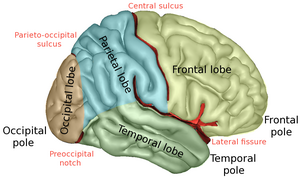Posterior cortical atrophy
| Posterior cortical atrophy | |
|---|---|
 |
|
| Lobes of the human brain | |
| Classification and external resources |
Posterior cortical atrophy (PCA), also called Benson's syndrome, is a form of dementia which is usually considered an atypical variant of Alzheimer's disease. The disease causes atrophy of the posterior part of the cerebral cortex, resulting in the progressive disruption of complex visual processing. PCA was first described by D. Frank Benson in 1988.
In rare cases, PCA can be caused by dementia with Lewy bodies and Creutzfeldt–Jakob disease.
PCA usually affects people at an earlier age than typical cases of Alzheimer's disease, with initial symptoms often experienced in people in their mid-fifties or early sixties. This was the case with writer Terry Pratchett (1948-2015), who went public in 2007 about being diagnosed with PCA. In The Mind's Eye, neurologist Oliver Sacks examines the case of concert pianist Lilian Kallir (1931–2004), who suffered from PCA.
The main symptom resulting from PCA is a decrease in visuospatial and visuoperceptual capabilities. Because the posterior region of the brain is home to the occipital lobe, which is responsible for visual processing, visual functions are impaired in PCA patients. The atrophy is progressive; early symptoms include difficulty reading, blurred vision, light sensitivity, issues with depth perception, and trouble navigating through space. Additional symptoms include apraxia, a disorder of movement planning, alexia, an impaired ability to read, and visual agnosia, an object recognition disorder. Damage to the ventral, or “what” stream, of the visual system, located in the temporal lobe, leads to the symptoms related to general vision and object recognition deficits; damage to the dorsal, or “where/how” stream, located in the parietal lobe, leads to PCA symptoms related to impaired movements in response to visual stimuli, such as navigation and apraxia.
...
Wikipedia
